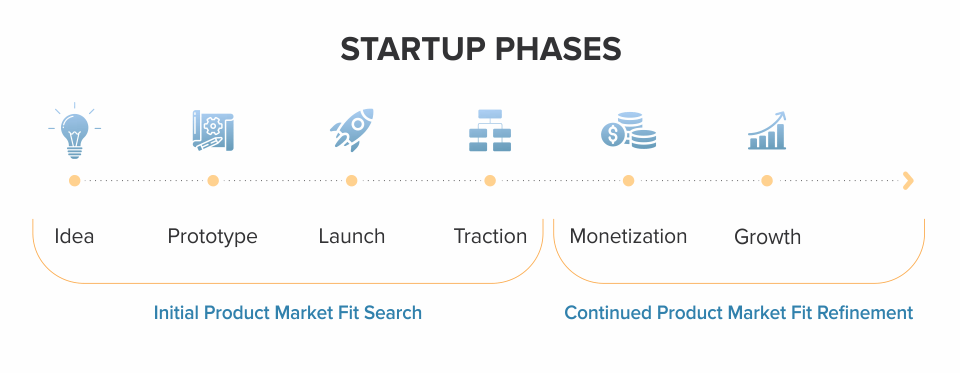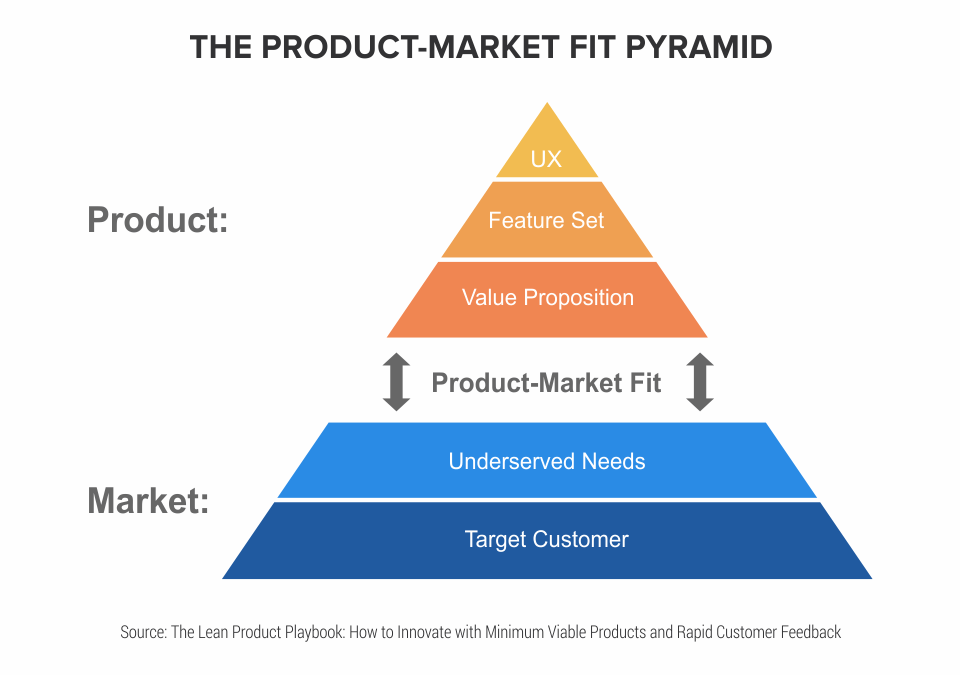Finding Product-Market Fit can be a gradual process especially if there’s no obvious business opportunity yet. Scaling too soon or missing an optimal time to grow can spell death for your startup. Reaching Product-Market Fit can seem back-breaking, but measuring it doesn’t have to be.
It doesn’t matter how sophisticated your idea is or how good you think your product is. It’s about whether anyone needs it and whether anyone is eager to pay for it.
It doesn’t take too much time to notice that you don’t have a product/market fit. You just need to be flexible enough to pivot very quickly. Most startups fail because they blow away cash without first carefully considering whether customers actually want what they are selling.
When you are solving a real problem, your potential customers/users will find you and they will many times even bug you to see if your product is ready or not. However, it’s not that easy to find a real customer pain. It takes hard work, dedication, the right strategy, flexibility, and of course sometimes you need some luck too.
If you have all of this, then you have chances to succeed. But this is just the beginning of a long journey. Achieving the product/market fit is the most important goals for a startup, yet it is also one of the least understood concepts.

Definition of Product Market Fit
The easiest way to understand the concept of product/market fit is to think that if a product satisfies a strong market demand, then you have achieved your product/market fit. This is easier said than measured though.
The product/market fit needs to be measured and tracked correctly since it’s an indicator of startup growth. And even if you have an established enterprise, you always need to take a look at your products and services from the perspective of product/market fit. Ask yourself if people still need your products/service. This is an essential question to keep your business growing.
Marc Andreessen, the co-founder of leading Silicon Valley venture capital firm Andreessen Horowitz, defined the term in his 2007 blog post as follows:
Product/market fit means being in a good market with a product that can satisfy that market.
To know Product/Market Fit you must first understand lean startup principles:
Most startups fail by wasting money on a product no one wants
Instead, launch early and test business model hypotheses with a minimum viable product
Pivot when a hypothesis is wrong
Repeat until you have Product/Market Fit
Don’t scale until you have Product/Market Fit
Product/Market Fit is being in the right market with a product that can satisfy that market. You can’t be all things to all people and sometimes even having the most reputable investors can’t save a startup from mismanagement.

How to Find Product Market Fit?
There is no one-fit-all solution for this. Remember, it always comes from the problem you are trying to solve and how significant that problem is for your target market. If people don’t care about that problem that much, then you are missing the first part of this whole ideology.
Then it comes to your product. Now that you are very confident that the problem you are trying to solve is actually big, you need to concentrate on how well your product is solving that problem. If you successfully pass those two tests, your customers will become real fans of your product.
There are six step framewrok that will eventually help you to find Product/Market Fit:
#1. Identify Your Target Customers
The target customer is the person who eventually decides whether to use your product or not. So, it makes sense to do market research and more specifically market segmentation to define your customer. Segmentation is all about dividing the market into segments which are similar in needs and behavior.
Market segmentation will help you define your “buyer personas” and describe them to your product team so that everyone understands who you are building the product for. To identify your target customer, you need to start from high-level research then refine and narrow down your choices until you find the ultimate buyer persona.
#2. Understand the Big Customer Needs
At this stage, your task is to determine the most significant needs of potential customers. It’s important to find specific needs that can create an excellent market opportunity. In other words, the needs have to be pretty compelling and vital for those customers.
#3. Know what you offer as a Value Proposition
The value proposition is mainly about how you are going to face the competition. The market might be full of similar product makers. So, you should come up with something utterly innovative and thoroughly ground-breaking to win people’s hearts and outperform your competitors.
When roadmapping your product processes, make sure to include new features, fresh new ideas, and stuff that can excite buyers. That will be your value proposition.
#4. Specify your Minimum Viable Product Feature Set
Whatever you are doing, it’s a must to start from somewhere. You can think about evolving later on. You will have to. Up until then, make sure to have a full list of things you want your MVP to have. For example, if the user has to create an account with your product, then they should be able to delete it at some point too. This is a very standard feature that your MVP should have.
Certain features make your product a viable product. But please don’t get too much carried away by the features. Include only the most important ones. I promise, you will get the chance to improve the product later on.
#5. Create Your Minimum Viable Product Prototype
This one is simple: don’t code until you have the prototype at hand. There are hundreds of prototyping and mockup tools out there such as UXPin, Sketch, InVision, etc. Use any of these to prototype your product then start testing it.
By testing, I mean showing it to your potential users, asking for opinions and feedback, observing their behavior. Most prototyping tools provide enough fidelity and interactivity to obtain critical feedback from customers.
#6. Test the MVP Prototype with Potential Customers
Once you got the MVP prototype, it’s time to get comments coming from the target audience. Don’t turn to your friends or family members unless they are potential customers of yours. Because by doing this, you are risking to get the wrong type of feedback.
Instead, give free access to your design prototype to anyone who you want to test it such as potential users, people who might end up buying the product later on when it’s ready.
During any kind of interaction with the potential user, make sure to observe what they say or do while using the prototype. Ask questions to clarify things for you, try to get deeper to get more insights. Avoid asking closed questions that involve Yes or No answers. Instead, encourage participation, brainstorming, idea-generation. Listen to your testers, identify patterns of similar comments, and then go find ways to improve the product.
This six-step process is going to ensure lots of consistency and clarity to the whole MVP building and testing cycle. With every new customer feedback, you are going to find new patterns and see the big picture more clearly. So, go ahead and take all these six steps towards building a better product.
Testing product/market fit
Testing the product/market fit consists of six major steps. We will go through each step separately.
#1. The 40% rule
One metric to test product/market fit is the so-called “40% rule.” And it’s really simple: if 40% of surveyed customers say that they would be “very disappointed” if they could no longer access your product or service, then you are on the winning side. Also, if at least 40% of your surveyed customers say that they consider your product a “must have” then again, you are on the winning side.
One of the sample questionnaire might sound like:
How'd you feel if you could no longer use the product?
Very disapointed
Somewhat dissapointed
Not dissapointed
I no longer use it
#2. Bounce Rate
The bounce rate is the percentage of users who visit a page on your website and then leave it before taking any action. In some instances, around 60% bounce rate is considered high. And this can mean that your website is not giving the right first impression to its visitors. So, a low bounce rate means a visitor’s expectations are met.
On the other hand, keep in mind that a high bounce rate does not necessarily mean that your business is useless. Users can bounce because of multiple reasons such as poor design or poor content/messaging.
There are a bunch of tools to measure the bounce rate. Uncle Google with its Google Analytics is the best for me.
#3. Time on Site
This is yet another thing you can use as a metric to test product/market fit. And it is even simpler than the bounce rate: the more time the user spends on your website, the more they like it.
But it’s hard to define a good average time on site. It somewhat depends on your niche, the type of product, and a lot of other factors. But if you want to track it, you can at least compare what the average time on site is for different months or weeks. This way you will be able to improve your site performance.
You can run an experiment to understand what can be an average time on your site. The actual time really depends on your content, functionality and how appealing both components are. For many software products, a time above 2 minutes is considered to be a bare minimum.
And again, for this and the rest of the metrics for testing the product/market fit, you can use Google Analytics as a fundamental tool. It has everything clearly and simply organized in one dashboard, and you have the chance to compare things and test and try…
#4. Pages Per Visit
This is the average number of pages a user travels through on your sire during a single visit. If the user visits more than 4–5 pages, it can be considered a high number already. And this indicated that the user/site visitor is interested in what they see on your website. Remember that a longer Time on Site and Pages per Visit indicate that the user experience is satisfactory.
#5. Returning Visitors
Returning visitors are the ones who have been to your website once and have decided to come back. The percentage of returning visitors can vary based on your industry. So, make sure to compare industry average values. Also, compare the number or percentage of returning visitors weekly and monthly for your website.
A big number of returning visitors reflects the lasting impact a product has on the customers. And if the rate of returning visitors is below 25%, then you have to work on your product harder.
#6. Customer Lifetime Value
The customer lifetime value can be defined as the average profit from each customer during the entire time they remain your client. If you want a sustainable business (which I am sure you do), you need to have repeat users who are eager to pay.
The customer lifetime value is directly linked to the profits you get. If you have got a high average customer lifetime value, you will be able to sustain your business model and allocate money to marketing and ads and improving your product to attract more users.
The idea of an average customer lifetime value is linked to your profitability. As a business owner, you can measure what should be the different levels of profitability for your business, hence getting insights about what should be your minimum customer lifetime value for your business to succeed.
Of course, there are a lot of other metrics you can track to test product/market fit. And you should be able to prioritize those metrics too. Basically, if the metrics mentioned above are above average and you meet the 40% rule, then congratulations, you have achieved product/market fit!
Final Thoughts
For a startup, meeting a few metrics is not enough to achieve market traction. Your product should have a high or extremely high degree of product/market fit. So, it’s important to understand whether you are just solving a problem or you are eliminating a huge burden from the users’ shoulders.
People already pay for a lot of things these days. Now, you cannot be just adding something new to their fees and bills. They won’t pay you if it’s only a solution to a minor problem. Your product should be life-changing, and it should excite people! Think about the difference between “Nice” and “Wow!” And keep that in mind every time you build your next product.





